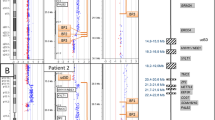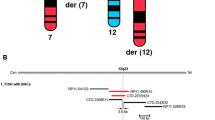Abstract
Backround
Microcephaly can either be isolated or it may coexist with other neurological entities and/or multiple congenital anomalies, known as syndromic microcephaly. Although many syndromic cases can be classified based on the characteristic phenotype, some others remain uncertain and require further investigation. The present study describes the application of array-comparative genomic hybridization (array-CGH) as a diagnostic tool for the study of patients with clinically unknown syndromic microcephaly.
Methods
From a cohort of 210 unrelated patients referred with syndromic microcephaly, we applied array-CGH analysis in 53 undiagnosed cases. In all the 53 cases except one, previous standard karyotype was negative. High-resolution 4 × 180K and 1 × 244K Agilent arrays were used in this study.
Results
In 25 out of the 53 patients with microcephaly among other phenotypic anomalies, array-CGH revealed copy number variations (CNVs) ranging in size between 15 kb and 31.6 Mb. The identified CNVs were definitely causal for microcephaly in 11/53, probably causal in 7/53, and not causal for microcephaly in 7/53 patients. Genes potentially contributing to brain deficit were revealed in 16/53 patients.
Conclusions
Array-CGH contributes to the elucidation of undefined syndromic microcephalic cases by permitting the discovery of novel microdeletions and/or microduplications. It also allows a more precise genotype–phenotype correlation by the accurate definition of the breakpoints in the deleted/duplicated regions.
Similar content being viewed by others
Log in or create a free account to read this content
Gain free access to this article, as well as selected content from this journal and more on nature.com
or
References
Abuelo D . Microcephaly syndromes. Semin Pediatr Neurol 2007;14:118–27.
Von der Hagen M, Pivarcsi M, Liebe J et al, Diagnostic approach to microcephaly in childhood: a two-center study and review of the literature. Dev. Med Child Neurol 2014;56:732–41.
Tzetis M, Kitsiou-Tzeli S, Frysira H, Xaidara A, Kanavakis E . The clinical utility of molecular karyotyping using high-resolution array-comparative genomic hybridization. Expert Rev Mol Diagn 2012;12:449–57.
Kerzendorfer C, Colnaghi R, Abramowicz I, Carpenter G, O'Driscoll M . Meier-Gorlin syndrome and Wolf-Hirschhorn syndrome: two developmental disorders highlighting the importance of efficient DNA replication for normal development and neurogenesis. DNA Repair 2013;12:637–44.
Seltzer LE, Paciorkowski AR . Genetic disorders associated with postnatal microcephaly. Am J Med Genet C Semin Med Genet 2014;166C:140–55.
Okamoto N, Ohmachi K, Shimada S, Shimojima K, Yamamoto T . 109 kb deletion of chromosome 4p16.3 in a patient with mild phenotype of Wolf-Hirschhorn syndrome. Am J Med Genet A 2013;161A:1465–9.
Paronett EM, Meechan DW, Karpinski BA, LaMantia AS, Maynard TMv . Ranbp1, deleted in DiGeorge/22q11.2 deletion syndrome, is a microcephaly gene that selectively disrupts layer 2/3 cortical projection neuron generation. Cereb Cortex 2015;25:3977–93.
Guilherme RS, Meloni VA, Perez AB et al, Duplication 9p and their implication to phenotype. BMC Med Genet 2014;15:142.
Abdallah-Bouhjar IB, Mougou-Zerelli S, Hannachi H et al, Molecular cytogenetic and phenotypic characterization of ring chromosome 13 in three unrelated patients. J Pediatr Genet 2013;2:147–55.
Walczak-Sztulpa J, Wisniewska M, Latos-Bielenska A et al, Chromosome deletions in 13q33-34: report of four patients and review of the literature. Am J Med Genet A 2008;146A:337–342.
Tan WH, Bird LM, Thibert RL, Williams CA . If not Angelman, what is it? A review of Angelman-like syndromes. Am J Med Genet A 2014;164A:975–92.
Bishop B, Ho KK, Tyler K et al, The chromatin remodeler chd5 is necessary for proper head development during embryogenesis of Danio rerio. Biochim Biophys Acta 2015;1849:1040–50.
Kim BJ, Zaveri HP, Shchelochkov OA et al, An allelic series of mice reveals a role for RERE in the development of multiple organs affected in chromosome 1p36 deletions. PLoS ONE 2013;8:e57460.
Abu-Amero KK, Hellani AM, Salih MA et al, A de novo marker chromosome derived from 9p in a patient with 9p partial duplication syndrome and autism features: genotype-phenotype correlation. BMC Med Genet 2010;11:135.
Gadea G, Blangy A . Dock-family exchange factors in cell migration and disease. Eur J Cell Biol 2014;93:466–77.
Resta N, Giorda R, Bagnulo R et al, Breakpoint determination of 15 large deletions in Peutz-Jeghers subjects. Hum Genet 2010;128:373–82.
Peddibhotla S, Khalifa M, Probst FJ et al, Expanding the genotype-phenotype correlation in subtelomeric 19p13.3 microdeletions using high resolution clinical chromosomal microarray analysis. Am J Med Genet A 2013;161A:2953–63.
Brandigi E, Molinaro F, Bulotta AL, Angotti R, Pavone M, Messina M . Chromosome 18q-syndrome and 1p terminal duplication in a patient with bilateral vesico-ureteral reflux: case report and literature revision. Ital J Pediatr 2013;39:6.
Giannikou K, Fryssira H, Oikonomakis V et al, Further delineation of novel 1p36 rearrangements by array-CGH analysis: narrowing the breakpoints and clarifying the "extended" phenotype. Gene 2012;506:360–8.
Ben-Shachar S, Ou Z, Shaw CA. et al, 22q11.2 distal deletion: a recurrent genomic disorder distinct from DiGeorge syndrome and velocardiofacial syndrome. Am J Hum Genet 2008;82:214–21.
Mikhail FM, Burnside RD, Rush B et al, The recurrent distal 22q11.2 microdeletions are often de novo and do not represent a single clinical entity: a proposed categorization system. Genet Med 2014;16:92–100.
Kobayashi H, Etoh K, Ohbayashi N, Fukuda M . Rab35 promotes the recruitment of Rab8, Rab13 and Rab36 to recycling endosomes through MICAL-L1 during neurite outgrowth. Biol Open 2014;3:803–814.
Wozniak K, Piaskowski S, Gresner SM et al, BCR expression is decreased in meningiomas showing loss of heterozygosity of 22q within a new minimal deletion region. Cancer Genet Cytogenet 2008;183:14–20.
Hoppe A, Heinemeyer J, Klopocki E et al, Interstitial 12p deletion involving more than 40 genes in a patient with postnatal microcephaly, psychomotor delay, optic nerve atrophy, and facial dysmorphism. Meta Gene 2014;2:72–82.
Sollis E, Graham SA, Vino A et al, Identification and functional characterization of de novo FOXP1 variants provides novel insights into the etiology of neurodevelopmental disorder. Hum Mol Genet 2016;25:546–57.
Lo Vasco VR . Role of phosphoinositide-specific phospholipase C η2 in isolated and syndromic mental retardation. Eur Neurol 2011;65:264–9.
Jordan VK, Zaveri HP, Scott DA . 1p36 deletion syndrome: an update. Appl Clin Genet 2015;8:189–200.
Speed D, Hoggart C, Petrovski S et al, A genome-wide association study and biological pathway analysis of epilepsy prognosis in a prospective cohort of newly treated epilepsy. Hum Mol Genet 2014;23:247–58.
Hu P, Wang Y, Meng LL et al, 1q25.2-q31.3 Deletion in a female with mental retardation, clinodactyly, minor facial anomalies but no growth retardation. Mol Cytogenet 2013;6:30.
Pennucci R, Talpo F, Astro V et al, Loss of either Rac1 or Rac3GTPase differentially affects the behavior of mutant mice and the development of functional GABAergic networks. Cereb Cortex 2016;26:873–90.
van der Heide LP, Wijchers PJ, von Oerthel L et al, FoxK2 is required for cellular proliferation and survival. J Cell Physiol 2015;230:1013–23.
Hamada N, Ito H, Iwamoto I et al, Role of the cytoplasmic isoform of RBFOX1/A2BP1 in establishing the architecture of the developing cerebral cortex. Mol Autism 2015;6:56.
Steinecke A, Gampe C, Zimmer G, Rudolph J, Bolz J . EphA/ephrinA reverse signaling promotes the migration of cortical interneurons from the medial ganglionic eminence. Development 2014;141:460–71.
Butler MG, Dagenais SL, Garcia-Perez JL et al, Microcephaly, intellectual impairment, bilateral vesicoureteral reflux, distichiasis, and glomuvenous malformations associated with a 16q24.3 contiguous gene deletion and a Glomulin mutation. Am J Med Genet A 2012;158A:839–49.
Fasching L, Kapopoulou A, Sachdeva R et al, TRIM28 represses transcription of endogenous retroviruses in neural progenitor cells. Cell Rep 2015;10:20–8.
Lee JA, Liu L, Javier R, Kreitzer AC, Delaloy C, Gao FB . ESCRT-III subunits Snf7-1 and Snf7-2 differentially regulate transmembrane cargos in hESC-derived human neurons. Mol Brain 2011;4:37.
Acknowledgements
We thank the families of the patients for their contribution.
Author information
Authors and Affiliations
Corresponding author
Ethics declarations
Competing interests
The authors declare no conflict of interest.
Rights and permissions
About this article
Cite this article
Tsoutsou, E., Tzetis, M., Giannikou, K. et al. Application of high-resolution array comparative genomic hybridization in children with unknown syndromic microcephaly. Pediatr Res 82, 253–260 (2017). https://doi.org/10.1038/pr.2017.65
Received:
Accepted:
Published:
Issue date:
DOI: https://doi.org/10.1038/pr.2017.65



